
Description
Save $96 with the Corrective Strategies Bundle.
This bundle includes all 5 Corrective Strategies Courses.
What's included in this Bundle
FMS Corrective Strategies: Hip Hinge Pattern
Lecture length: 1 hour, 4 minutes
In this practical overview of the hip hinge pattern, Gray Cook discusses assessment and screening for pain/dysfunctions and dismantles misconceptions that often affect corrective exercise selection. Hip hinge issues are not always posterior chain problems, nor do they always point towards a mobility strategy (despite usually involving tension).
Gray progresses through 13 exercises structured by posture and the ABCs (Awareness, Breathing and Control), including half-kneeling and tall-kneeling transitions, RNT deadlifts, chops and lifts, and RNT walking and running. Specific attention is given to using exercise to provide the client with awareness of their current movement issue and use that information to build competency in the pattern.
Before ballistic work with kettlebells, running or deadlifts, Gray shows you how to get the pattern organized first so that your training can build on a proper hip hinge.
FMS Corrective Strategies: Upper Body Patterns
Lecture length: 1 hour
Correcting shoulder mobility involves much more than just stretching the shoulders - and it's one of the patterns where poor exercise choices can cause significant problems. Regardless of the screen or assessment you use to identify shoulder dysfunction, it almost always prompts consideration of neck problems, overall posture and left/right imbalances (think throwing and rotational athletes). The SFMA, FMS and Symmio each use a variation of reaching pattern to look at shoulder mobility, taking into account movement from the hand, wrist, elbow, and shoulder. The latter two screens look at both shoulders simultaneously because of their shared connection point (the spine) and how they are used to counterbalance each other.
Gray Cook presents an exercise progression that starts with rolling, moves through chops and lifts, deadlifts and windmills and ends with his six-position carry. These corrective exercises focus on the calibration - syncing the shoulder with the posture and ensuring upper body stability - that needs to happen before conditioning activities.
Gray unpacks the importance of shoulder girdle stability, tissue mobility, and breath sequence as he uses variations in spine posture to support functional shoulder movement.
FMS Corrective Strategies: Rotation Patterns
Lecture length: 56 minutes
Rotation patterns are often targeted when we find asymmetries in mobility and stability. These problems in turning, twisting and weight shifting are manifestations of a core imbalance and are identified in multiple screens and assessments used by Functional Movement Systems.
To correct these imbalances and asymmetries in the dissociation and (re)association of the lower body and upper body, we start at the fundamental level because rotation is the developmental foundation of many other movements. Gray Cook uses variations of rolling, chops and lifts, rotation exercises with Indian clubs and kettlebells in this progression that is aimed at dumping unnecessary tension and holding alignment on one’s axis.
Gray provides guidance on differentiating problems in tissue from those in muscle tone as well as focusing on the specific importance of proper breathing to rotation patterns. If you work with clients who participate in swinging or throwing sports, this course provides the functional exercise background you need to bring awareness to their dysfunctions while correcting them at the proper postural level.
FMS Corrective Strategies: Balance Patterns
Lecture length: 1 hour, 2 minutes
The ability to balance on one leg can tell us a lot about your movement - that ‘automatic’ balance is an integral part of your gait, and any activity that involves locomotion. In this overview of single-leg patterns, Gray Cook dissects balance from the bottom up and explains why balance issues are difficult to coach at the conscious level. Remember this when balance is in question: perception drives behavior.
Gray reviews the different assessments and screens that FMS uses to identify pain and movement dysfunctions and asymmetries within single-leg stance patterns and discuss how to separate mobility problems from stability problems.
The 12 exercises demonstrated are selected to grow balance behavior through perceptive milestones. Gray uses variations of rolling, crawling, toe touches and RNT step ups as exercises that don’t practice the tests and assessments yet are great checks for single-session change.
FMS Corrective Strategies: Squat Pattern
Lecture length: 55 minutes
Plain and simple, there’s no good reason to lose your squat pattern. Foregoing acute injury, this pattern usually goes away from either overuse of the lower body (think avid runner) or reduced activity level. We can’t be content with the loss of such an important developmental milestone - and that’s why we assess it for pain and screen it for dysfunction. We look at a general ‘squeeze’ of multi-segmental flexion: Do all of your joints contribute in an extreme position? Are there right/left differences in ankle, knee, hip or shoulder flexion? Can your core span the required upper and lower body mobility?
Gray Cook’s selections for his squat pattern exercise progression unpack the movement from the ground up - fundamental before functional - and look for common tone and tissue concerns, especially in regards to posterior chain tightness and asymmetrical weight bearing. Beginning with rolling, the exercises move up through the postures through tall-kneeling and half-kneeling reaches and turns, RNT challenge exercises and finally in Gray’s take on an overhead squat.
The FMS philosophy still prevails here - correct other patterns first and recheck their impact on the squat. Remember, conditioning should serve to make a person strong and reactive in their squat, but it should never take the squat pattern away.
